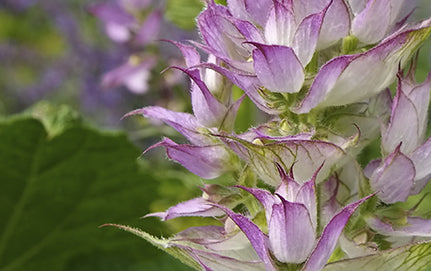Sweet, warm and balancing, balsamic clary sage produces an essential oil that is wise beyond its leaves.
Plant name (Latin): Salvia sclarea
Plant family: Lamiaceae (mint family)
Native region: Mediterranean basin
Growing habit: Flowering biennial, growing up to a metre tall
Parts used: Flowers
Essential oil extraction method: Steam distillation from the blossoms
About Clary Sage Oil
Clary sage, a relative of the sage used in cooking, has been known for its beneficial properties for thousands of years. Unlike culinary sage, it is the delicate mauve, white and pink blossoms that are used to create as a warm, sweet, balancing essential oil. Clary sage is also used as a flavour element in vermouth, and is an important component of many fragrances. The essential oil has a balsamic, sweet-herbaceous aroma, with nutty, woody and tobacco notes.

Why Use Clary Sage Oil
A warm, sweet, and lively tonic that comforts the body and mind. Used in aromatherapy to soothe digestive discomfort, headaches, sore throats, and muscle aches and pains.
How and Where Clary Sage Grows
Clary sage is a herbaceous biennial (a short-lived perennial with a lifespan of two years). It’s native to the Mediterranean Basin, and can be found in a few places in North Africa and Central Asia. As a garden plant, it grows well in poor, dry soil, and thrives with plenty of sun. Today, clary sage is cultivated in Central Europe, England, Morocco, the United States and Russia.
Clary sage is related to common sage (salvia officinalis), otherwise known as culinary sage, or simply “sage”. The plants look quite similar, but clary sage grows to roughly double the size of common sage. In its first year, clary sage forms a rosette (a circular formation of leaves), and in its second year, a flower stalk forms. Clary sage is fast-growing and can grow to over metre tall (3-4 feet). At its base, clary sage leaves are about a foot) long, tapering to half that length higher up on the plant. Clary sage leaves are called rugose: a botanical term for ‘wrinkled’, and have glandular hairs on their surface. The flowers grow in whorls, and can be mauve, lilac, white or pink. Blooms appear in early summer, as long as the plant gets lots of sun.
Clary sage can survive in very dry, nutrient-poor soil, but it doesn’t like being waterlogged. It’s hardy to USDA Zone 5 (areas with a minimum average winter temperature of −23°C or −10°F).
Clary Sage in All Its Forms
CLARY SAGE ESSENTIAL OIL
Clary sage essential oil is steam-distilled from clary sage flowers. The blooms are gathered toward the end of their bloom cycle, when volatile oil levels are highest. The flowers are gathered in the afternoon to further maximize oil levels, but the weather needs to be just right. Too hot, and the heat vaporizes the oil, and rain or humidity lowers the yield of oil. To prevent oil from evaporating from the blooms, the flowers are processed as soon as possible after being gathered.
CULINARY USES OF CLARY SAGE
Clary sage is a relative of sage, the common cooking herb often used in foods like stuffing and brown butter sauce. When clary sage is very young, the leaves can be used for cooking but the leaves get tough and bitter as they mature. While it’s not the best herb for cooking, clary sage is used to flavour vermouths, wines and liqueurs. In fact, in Germany it’s known as Muscatel sage, because it was once used to flavour wines to make an imitation Muscatel (a wine made from muscat grapes).
CLARY SAGE IN FRAGRANCE
Clary sage is often used in the fragrance industry as a fixative (an ingredient that binds and intensifies scent). Clary sage can act in fragrance in much the same way ambergris does, providing a sustainable, vegetarian, environmentally-friendly alternative to ambergris, which is produced by whales.
Clary Sage Oil and Stress
Clary sage oil is renowned for its stress-relieving properties. The oil contains compounds such as linalyl acetate and linalool, which are known to have calming effects on the nervous system. When used in aromatherapy, clary sage oil can help reduce stress and anxiety, promoting a sense of relaxation and well-being. Diffusing clary sage oil or adding it to a warm bath are popular methods for harnessing its stress-relieving benefits. Additionally, clary sage oil can be blended with other calming oils like lavender or bergamot for enhanced effects.
Clary Sage Oil in Ayurveda
In Ayurvedic medicine, clary sage is considered to be an all-round, beneficial tonic that can help bring the three doshas (vata, pitta and kapha) into balance. It is thought to help increase physical and emotional strength. It is thought to soothe the mind and body, inspire mental clarity and confidence, release stress, encourage a restful sleep, and soothe and revitalize skin. Clary sage is thought to stimulate the root and sacral chakras.
The Symbolism of Clary Sage
The English name for clary sage comes from the Latin “claris” for “clear”, a reference to its traditional use as an eye treatment. Centuries ago, the seeds were soaked in water until a mucilaginous coating formed, then they were placed in the eye to draw out foreign objects. Today, this usage is not advised: instead, go to your eye doctor for assistance!
Clary sage has been known by many other names through the ages, including: Clear Eye, See Bright, Eyebright, and Clarywort. During the Middle Ages, it was known as Ocultus Christi, or “Eye of Christ”, and was highly valued for its medicinal properties.
The Latin name for clary sage, Salvia sclarea, comes from the Latin salvere (to feel well, to feel healthy, heal) and the Greek word skeria (hard), in reference to its leaves. Pliny the Elder, a Roman writer, was the first to describe the salvia family of plants, which includes a variety of types of sage. The various members of the sage family were all considered extremely useful for healing, hence the name salvia.
In magical traditions, the association of clary sage with vision leads to its use as aid for meditation or visionary states. It is said to help enhance the ability to dream and remember dreams, and can also be used in love spells.
In his 1653 book, The Complete Herbal, Nicholas Culpeper associates clary sage with the power of the moon.
The History of Clary Sage

Clary sage was used widely in folk medicine throughout the ancient world. In the 4th century BCE, Greek philosopher Theophrastus wrote about clary sage, and Pliny the Elder discussed it in the 1st century CE. The Romans used clary sage for a variety of ailments, including as a eyewash, and as a treatment for a variety of women’s health concerns.
Throughout the Middle Ages, clary sage continued to be known and used throughout Europe as a useful herb. In the 1600s, English herbalist Nicholas Culpepper documented the various traditional uses of clary sage. Culpepper recommended eating “the fresh leaves dipped in a batter of flour, eggs, and a little milk, and fried in butter, and served to the table” to help a sore back.
Culpepper warned about mixing wine and clary sage, as “the seeds or leaves taken in wine, provokes to venery” (i.e. acts as an aphrodisiac). In the middle ages, it was common to use clary sage instead of hops in beer, and clary sage was used in Germany to flavour Rhine wine, to imitate (the much more expensive) Muscatel wine. Despite (or maybe because of) Culpepper’s warning, clary sage continues to flavour a number of liqueurs to this day, including vermouth.
The Science of Clary Sage Oil
As well as a flavouring and an essential oil, clary sage is used as an ingredient in fragrance. Clary sage contains sclareol, a scent molecule that can be used to mimic the effects of ambergris in perfume. Ambergris, a substance produced by whales with a tummy ache, is an extremely rare substance that acts as a perfume fixative. It’s also illegal in the United States, and many other jurisdictions, and has been since the 70s. Fortunately, in the 1960s, chemists looking for additives to improve the taste of tobacco had isolated sclareol, and by the 70s, perfumers realized it could be used to help maintain scents in a sustainable and cruelty-free way.
In the US, the commercial clary sage crop is concentrated in northeastern North Carolina, where hundreds of acres of it can be seen blooming every summer.

